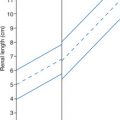Chapter 2. Biliary System
Patient Preparation
• Patients should fast for 6 to 12 hours; emergency examinations may be done with or without fasting.
Equipment and Technical Factors
• A curved linear multihertz transducer is preferred; a sector/vector transducer may be required for intercostal imaging.
• Decrease the dynamic range to produce higher contrast in images of the gallbladder and ducts; use of harmonics is recommended.
• Color Doppler imaging can be used to distinguish vascular from nonvascular structures, especially in cases where hepatic artery or bile duct variants are present.
Imaging Protocol
Minimum documentation images for the gallbladder
• Longitudinal axis images of the medial, mid, and lateral portions.
• Transverse axis images of the proximal (neck), mid (body), and distal (fundus).
• Measure anterior gallbladder wall in a longitudinal or transverse midgallbladder image; any region of suspected wall thickening should be measured.
• At least two of the following patient positions must be used: supine, left lateral decubitus, upright/semiupright, or prone. Other positions may be helpful.
Minimum documentation images for the extrahepatic bile duct
• Longitudinal images of the extrahepatic bile duct proximal, mid, and distal with lumen measurements or measurement at largest diameter. Transverse axis image(s) of the portal triad or common bile duct at the head of pancreas should be included.
Normal Variants
• Phrygian cap (fundus of gallbladder): does not change with patient position.
• Junctional gallbladder fold: with change in patient position, fold may or may not persist.
• Variation of shape: gallbladder is more round or elongated than oval/pear shaped.
• Variations in the location where the cystic duct joins with the common hepatic duct and accessory hepatic ducts may be seen.
Sonographic Measurements
• Gallbladder: <4.0 cm in anteroposterior and transverse and <8.0−12.0 cm longitudinal; wall thickness <3.0 mm anteroposterior.
• Biliary ducts
Common hepatic duct: <4.0 mm
Common bile duct, <65 years of age: 6.0−7.0 mm
Common bile duct, >65 years of age: 10.0 mm
Post cholecystectomy: 6.0−11.0 mm
| Biliary System | |||
|---|---|---|---|
| Sonographic Finding(s) | Clinical Presentation | Differential Diagnosis | Next Step |
Low-level echoes within GB May see layering effect May appear as “mass” | Asymptomatic or Symptoms and laboratory values as seen in acute cholecystitis Prolonged fasting state | Sludge/viscid bile | May be transient because of the patient’s fasting state or related to gallbladder disease |
Echogenic, mobile structure(s) with shadowing within GB May “layer” | Asymptomatic or right upper quadrant pain Nausea Vomiting Positive Murphy’s sign Labs: elevated direct bilirubin and LFTs | Cholelithiasis | Ensure that a high-frequency and focal zone is properly placed Color Doppler imaging may be used to demonstrate the “twinkle” sign in the presence of tiny stones Evaluate for hepatic biliary obstruction, pancreatitis |
| GB wall thickening, possible gallstone(s), with/without pericholecystic fluid | Possible: RUQ pain Nausea Vomiting Positive Murphy’s sign Fever Labs: elevated direct bilirubin with obstruction | Cholelithiasis with acute cholecystitis | Associated with biliary obstruction and pancreatitis, especially when tiny/small gallstones are present Increased flow may be noted in the cystic artery |
| Wall is uniformly thickened, with/without pericholecystic fluid | Sudden onset of RUQ pain, possibly radiating to right shoulder or back Fever Nausea Vomiting Positive Murphy’s sign Labs: elevated LFTs, serum amylase Leukocytosis | Acute cholecystitis Hepatitis (marked thickening) AIDS cholangiopathy Sclerosing cholangitis | Commonly associated with cholelithiasis |
| Wall is uniformly thickened and the gallbladder is small despite patient fasting | Transient RUQ pain for 6 months or greater Dyspepsia Fat intolerance Flatulence Nausea Vomiting Labs: elevated LFTs and serum amylase | Chronic cholecystitis | Commonly associated with cholelithiasis Disease may be noted in the liver, bile ducts, and pancreas |
Distended gallbladder not seen; echogenic area with shadowing noted in gallbladder fossa area WES sign | Chronic symptoms: Bloating Belching Food avoidance RUQ pain Negative Murphy’s sign | Chronic cholecystitis/cholelithiasis Collapsed/nondistended GB Loop of bowel | Associated with biliary obstruction or pancreatitis |
| Wall is uniformly thickened and the gallbladder is small despite patient fasting | Transient RUQ pain for 6 months or greater Dyspepsia Fat intolerance Flatulence Nausea Vomiting Labs: elevated LFTs and serum amylase | Chronic cholecystitis | Commonly associated with cholelithiasis
Stay updated, free articles. Join our Telegram channel
Full access? Get Clinical Tree


|

